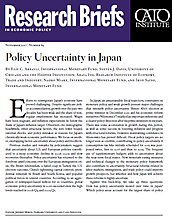Efforts to reinvigorate Japan’s economy have proved challenging. Despite significant policy accommodation, growth over the past two decades has been weak and the share of nonregular employment has increased. Wages have been stagnant, and inflation expectations lie below the Bank of Japan’s inflation target. Observers cite demographic headwinds, other structural factors, the zero lower bound, external shocks, and policy mistakes as reasons for Japan’s chronically weak economic performance. We focus on another, overlapping factor: uncertainty about policy and its effects.
Previous studies and remarks by policymakers suggest that uncertainty about U.S. and European policies contributed to a steep economic decline in 2008–2009 and slow recoveries thereafter. Policy uncertainty has returned to the forefront amid concerns over the European immigration crisis, the Brexit referendum, a failed coup in Turkey, the U.S. election outcome, China’s tightening capital controls, presidential removals in Brazil and South Korea, and populist political forces in several countries. According to an aggregation of newspaper-based indices for 16 countries, global economic policy uncertainty in 2016 exceeded even the high levels reached in 2008 Q4 and 2009 Q1.
In Japan, an unsustainable fiscal trajectory, constraints on monetary policy, and weak growth present major challenges that intensify policy uncertainty. Shinzo Abe’s election as prime minister in December 2012 and his economic reform initiatives (“Abenomics”) marked an important milestone and a clearer policy direction after six prime ministers in six years. There was some acceleration in growth during this period, as well as some success in boosting inflation and progress with structural reforms. However, maintaining confidence in Abenomics has proved difficult. Fiscal policy targets are no longer seen as credible, contributing to policy uncertainty. A consumption-tax hike initially scheduled for 2015 was postponed twice, first to 2017 and then to 2019. The frequent use of supplementary budgets adds to uncertainty about the near-term fiscal stance. New monetary-easing measures and technical changes to the monetary policy framework also contribute to uncertainty. Structural reforms related to labor markets, immigration, and trade policy could improve growth prospects, but whether and how Japan will achieve these reforms is highly uncertain.
Against this backdrop, we take up three questions: How has policy uncertainty moved over time in Japan? Which policy areas account for the largest share of policy uncertainty and its movements? What do changes in policyrelated uncertainty portend for Japan’s economic performance? To address these questions, we construct several newspaper-based policy uncertainty measures for Japan. We interpret these measures as proxies for policy-related uncertainty, as perceived by households and businesses. We relate our measures to other uncertainty measures, examine their behavior over time, and consider their dynamic relationship to aggregate economic performance.
Our measures aim to capture uncertainty about who will make economically relevant policy decisions, what policy actions will be undertaken and when, and the economic effects of policy actions (or inaction). To construct our overall measure of economic policy uncertainty (EPU), we count articles in four major Japanese newspapers (Yomiuri, Asahi, Mainichi, and Nikkei) that contain at least one term in each of three categories: (E) economic or economy; (P) tax, government spending, regulation, central bank, or certain other policy-related terms; and (U) uncertain or uncertainty. We also construct uncertainty indices for monetary policy, fiscal policy, trade policy, and exchange-rate policy. To do so, we specify additional criteria for those articles that contain our triad of terms about the economy, policy, and uncertainty. All of our measures are monthly from 1987 to the present.
Our overall EPU index peaks during the Asian Financial Crisis and in reaction to the failure of Lehman Brothers, the U.S. debt-ceiling fight in 2011, the Brexit referendum, and the recent deferral of a hike in the consumption-tax rate. The index also shows a clear tendency to rise around contested national elections and major leadership transitions. It displays moderately countercyclical fluctuations, perhaps because policymakers are more inclined to experiment with new policies in bad times.
Uncertainty indices for fiscal, monetary, trade, and exchange-rate policy correlate positively with one another, while also displaying distinct and intuitive dynamics. Among all articles that satisfy our E, P, and U criteria, 57 percent reference fiscal policy matters, 27 percent reference monetary policy, 8 percent reference trade policy, and only 3 percent reference exchange-rate policy. This finding strongly suggests that fiscal matters are the most important source of policy uncertainty in Japan, at least as perceived by journalists and their editors and, presumably, typical newspaper readers as well.
Our EPU measures have predictive power for Japan’s economic performance conditional on standard measures of economic activity and uncertainty. In particular, upward EPU innovations foreshadow deteriorations in Japan’s macroeconomic performance. We also find a significant effect of global economic policy uncertainty on Japan’s economic performance. These results do not prove a causal effect of policy uncertainty on economic performance, but they show that our EPU index contains useful information not captured by other forward-looking indicators.
NOTE:
This research brief is based on Elif C. Arbatli, Steven J. Davis, Arata Ito, Naoko Miake, and Ikuo Saito, “Policy Uncertainty in Japan,” NBER Working Paper no. 23411, May 2017, http://www.nber.org/papers/w23411; also available as IMF Working Paper no. 17/128, May 2017, https://www.imf.org/en/Publications/WP/ Issues/2017/05/30/Policy-Uncertainty-in-Japan-44915.
